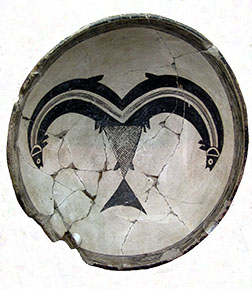Maxwell Museum Blog

In the isolated mountain valleys and hot deserts of southwestern New Mexico lie the remains of perhaps a hundred or more small villages where Native Americans now known as the Mimbres people lived between about 1000 and 1150 C.E. (current era). These ruins would offer little of interest to anyone but the inhabitants of the region and a handful of archaeologists if they had not yielded up a remarkable kind of painted pottery. The name for this ware -Mimbres Black-on-white, or Mimbres Classic Black-on-white -is misleading. The paint is often brown or red rather than black, and the background color may be light gray, cream, or buff rather than white. By any name, Mimbres Black-on-white appears to be a climax ware, a type of pottery on which a certain set of visual ideals and values was pushed to its ultimate limits. This achievement of the Mimbres potters seems highly improbable, for in the expectations of the generation of scholars who first studied them, they were the wrong people, living in the wrong place and under the wrong circumstances, to carry that particular tradition to a climax.
The hallmarks of Mimbres Black-on-white are complex geometric, representational, and narrative paintings, often made with an elegant line and powerful, dynamic masses of dark and light areas always placed within framed picture spaces. The most usual painting surface for a Mimbres artist was the interior of a hemispherical bowl. With limited technical means but deft skill, using only a few compositional systems and fewer elements, these artists organized and reorganized their concave picture spaces into myriad complex patterns. At their worst they produced moderately pleasing decorations, and at their best, powerful statements of that mysterious decorative-expressive duality that we call art. Iconographically and visually, the finest Mimbres paintings are at once simple and complex, clear and obscure, easily perceived and impossible to read. That several generations of subsistence farmers living in small, isolated villages should have produced art of this order is the central art-historical problem posed by Mimbres painting.
With Mimbres as with many other ancient arts, the historical, humanizing data that exist are fragmentary and poorly understood. Reordering this limited knowledge so that it yields all possible information about the meanings Mimbres art night have had for Mimbres people is an absolutely necessary first step in reconstructing its history. We have three major sources for such data on the Mimbreños: archaeology, ethnology, and the existing paintings. The Mimbres people, for all of the interest their art has generated, were until recently among the most poorly known of all ancient Southwestern peoples. The most comprehensive archaeological information about them has been developed largely since the 1970s and reported on since the 1980s. Data obtainable through ethnology are necessarily problematical, because identification of the Mimbres as ancestral to any contemporary people is a complex and uncertain proposition. Even if this were not the case, the many hundreds of years that separate the Mimbreños from the modern world would make questionable any assumptions based on the oral traditions or practices of any modern people. The paintings themselves, especially those that represent humans and human activities, do offer a rich source of information. Treated as documents, and in the light of knowledge culled from other sources, they can help flesh out the skeletal structure of Mimbres history. To often, however, the paintings lack essential dating and provenience information, so they are incomplete as historical documents.
Reprinted by permission from Mimbres Painted Pottery, Revised Edition
by J. J. Brody. Copyright 2004 by SAR Press, Santa Fe, New Mexico. All rights reserved.
Available in the Maxwell Museum Store
Mimbres pottery from the Maxwell Museum of Anthropology Collection on Pinterest

